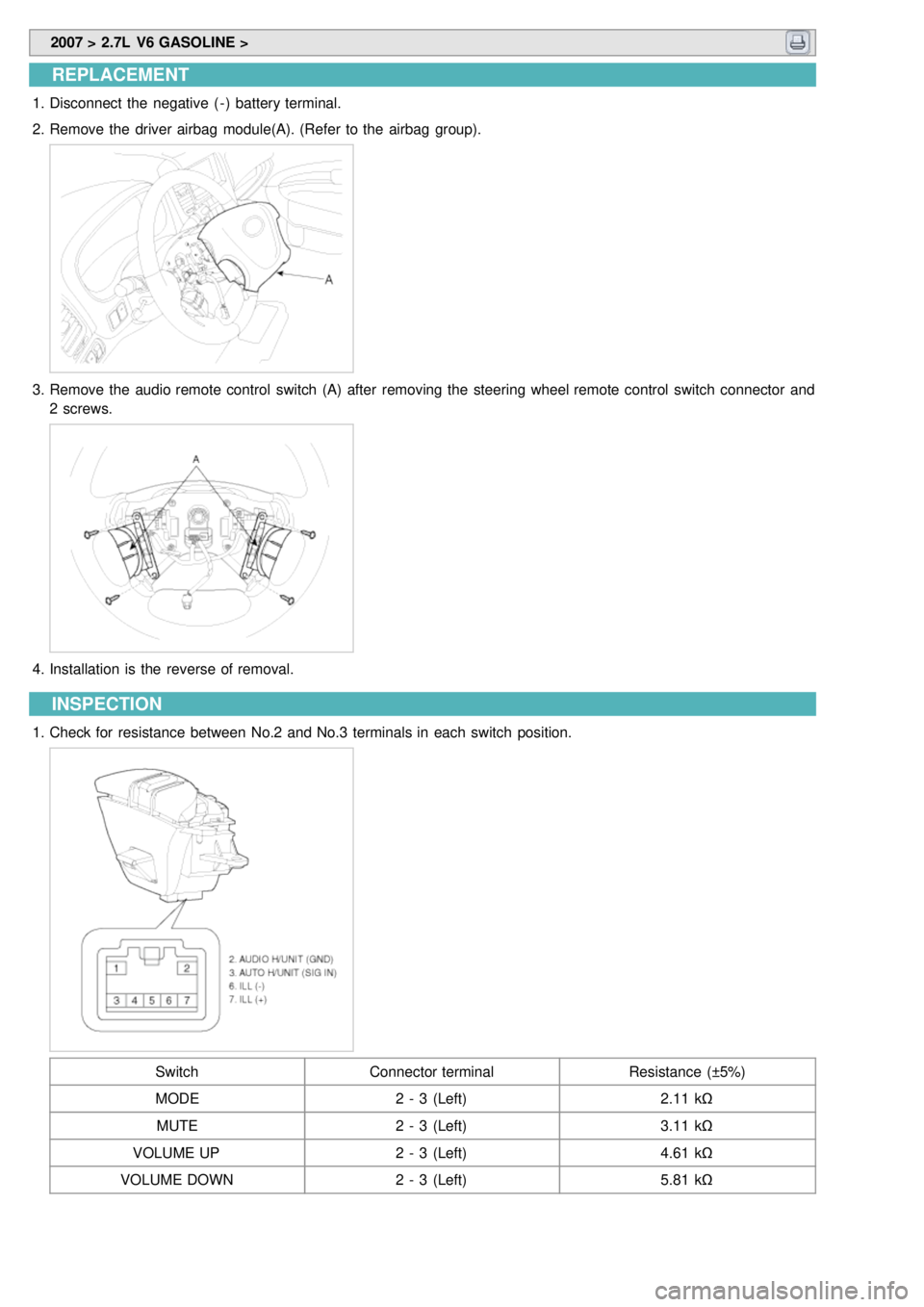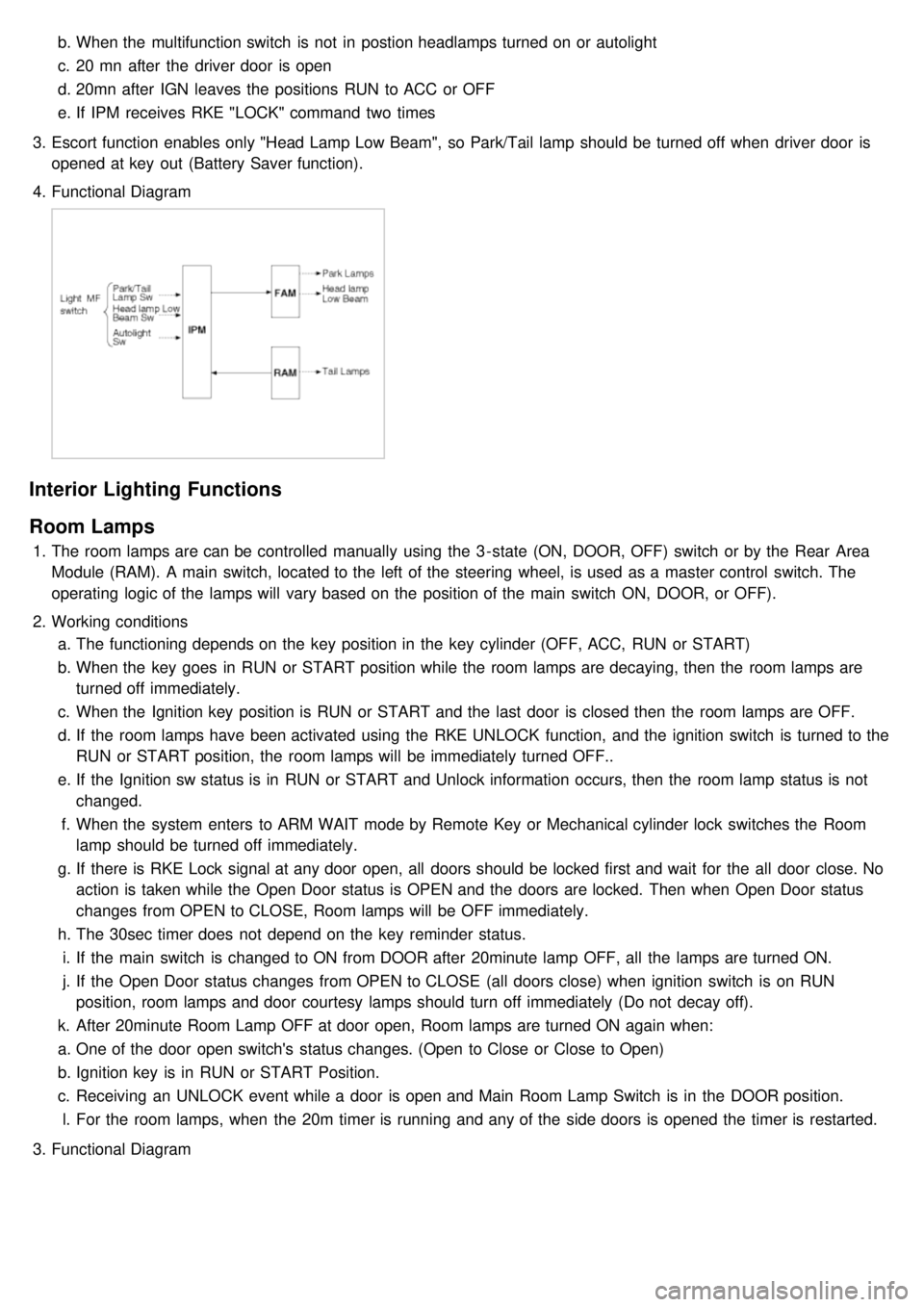2007 KIA CARNIVAL steering wheel
[x] Cancel search: steering wheelPage 946 of 1575

DTCDESCRIPTION WARNING LAMP
REMARK
ABS EBDESC
C1101 BATTERY VOLTAGE HIGH ООО
C1102 BATTERY VOLTAGE LOW ОО
C1200 FL WHEEL SPEED SENSOR- OPEN/SHORT ОО
C1201 FL WHEEL SENSOR- RANGE/ PERFORMANCE ОО
C1202 FL WHEEL WHEEL SPEED SENSOR- NO SIGNAL ОО
C1203 FR WHEEL SPEED SENSOR- OPEN/SHORT ОО
C1204 FR WHEEL SENSOR- RANGE/ PERFORMANCE ОО
C1205 FR WHEEL SPEED SENSOR- NO SIGNAL ОО
C1206 RL WHEEL SPEED SENSOR- OPEN/SHORT ОО
C1207 RL WHEEL SENSOR- RANGE/ PERFORMANCE ОО
C1208 RL WHEEL SPEED SENSOR- NO SIGNAL ОО
C1209 RR WHEEL SPEED SENSOR- OPEN/SHORT ОО
C1210 RR WHEEL SENSOR- RANGE/ PERFORMANCE ОО
C1211 RR WHEEL SPEED SENSOR- NO SIGNAL ОО
C1213 WHEEL SPEED FREQUENCY ERROR ОО
C1235 PRESSURE SENSOR- ELECTRICAL ОESP
C1237 PRESSURE SENSOR- SIGNAL FAULT ОESP
C1260 STEERING ANGLE SENSOR- SIGNAL ОESP
C1261 STEERING ANGLE SENSOR NOT CALIBRATED ОESP
C1282 YAW RATE & LATERAL G SENSOR- ELECTRICAL ОESP
C1283 YAW RATE & LATERAL G SENSOR- SIGNAL ОESP
C1503 ESP SWITCH ERROR ОESP
C1513 BRAKE LIGHT SWITCH MALFUNCTION О
C1604 ECU HARDWARE ERROR ООО
C1605 CAN CONTROL HARDWARE ERROR ОESP
C1611 CAN TIME OUT- PCM(ECM) ОESP
C1612 CAN TIME OUT- PCM(TCM) ОESP
C1616 CAN BUS OFF ОESP
C1623 CAN TIMEOUT STEERING ANGLE SENSOR ОESP
C1625 CAN TIME OUT- ESP ОESP
C1626 IMPLAUSIBLE CONTROL ООESP
C1702 VARIANT CODING ООО ESP
C2112 VALVE RELAY MALFUNCTION ООО
C2308 FL INLET VALVE MALFUNCTION ООО
C2312 FL OUTLET VALVE MALFUNCTION ООО
C2316 FR INLET VALVE MALFUNCTION ООО
C2320 FR OUTLET VALVE MALFUNCTION ООО
C2324 RL INLET VALVE MALFUNCTION ООО
C2328 RL OUTLET VALVE MALFUNCTION ООО
Page 967 of 1575

2007 > 2.7L V6 GASOLINE >
description of ESP
Optimum driving safety now has a name : ESP, the Electronic Stability Control.
ESP recognizes critical driving conditions, such as panic reactions in dangerous situations, and stabilizes the vehicle
by wheel- individual braking and engine control intervention with no needfor actuating the brake or the gas pedal.
ESP adds a further function known as Active Yaw Control (AYC) to the ABS, TCS, EBD and ESP functions. Whereas
the ABS/TCS function controls wheel slip during braking and acceleration and, thus, mainly intervenes in the
longitudinal dynamics of the vehicle, active yaw control stabilizes the vehicle about its vertical axis.
This is achieved by wheel individual brake intervention and adaptation of the momentary engine torque with no need
for any action to be taken by the driver.
ESC essentially consists of three assemblies : the sensors, the electronic control unit and the actuators.
Of course, the stability control feature works under all driving and operating conditions. Under certain driving
conditions, the ABS/TCS function can be activated simultaneously with the ESP function in response to a command
by the driver.
In the event of a failure of the stability control function, the basic safety function, ABS, is still maintained.
DESCRIPTION OF ESP CONTROL
ESP system includes ABS/EBD, TCS and AYC (Active yaw control) function.
ABS/EBD function : The ECU changes the active sensor signal (current shift) coming from the four wheel sensors to
the square waveform.By using the input of above signals, the ECU calculates the vehicle speed and the acceleration
& deceleration of the four wheels.And, the ECU judges whether the ABS/EBD should be actuated or not.
TCS function prevents the wheel slip of drive direction by adding the brake pressure and engine torque reduction via
CAN communication.TCS function uses the wheel speed sensor signal to determine the wheel slip as far as ABS
function.
AYC function prevents unstable maneuver of the vehicle. To determine the vehicle maneuver, AYC function uses the
maneuver sensor signals(Yaw Rate Sensor, Lateral Acceleration Sensor, Steering Wheel Angle Sensor).If vehicle
maneuver is unstable (Over Steer or Under Steer), AYC function applies the brake pressure on certain wheel, and
send engine torque reduction signal by CAN.
After the key - on, the ECU continually diagnoses the system failure. (self- diagnosis)If the system failure is detected,
the ECU informs driver of the system failure through the BRAKE/ABS/ESP warning lamp. (fail- safe warning)
Page 986 of 1575

2007 > 2.7L V6 GASOLINE >
DESCRIPTION
GENERAL DATA
The steering angle speed sensor detects the angle of the steering wheel in order to which direction a user chooses.
MEASUREING PRINCIPLE
A non contact, analog angle sensor carrying out absolute measuring by the use of the Anisotropic - Magneto- Resistive
effect (AMR).Measuring of the absolute angle by means of a toothed measuring gear with magnetic properties in
combination with different ratios. Corresponding AMR elements that change their electrical resistance according to the
magnetic field direction detect the angle position of the measuring gears.A micro- controller decodes the measured
voltage signals after A/D converting with the help of a mathematical function. Output of the digital angle value and
velocity via CAN- interface.
SPECIFICATION
Description Specification
Operating voltage 8~16 V
Operating temperature - 40 ~ 85 °C
Current consumption Max.150 mA
Steering angle velocity Max. ±2000 °/sec
Connection delay time t < 200 ms
Reverse voltage - 13.5 V
Measuring range Angle
- 780 ° ~ 779 °
Angular velocity 0~ 1016 °/s
Nonlinearity angle - 2.5 ° ~ +2.5 °
Hysteresis angle 0 ° ~ 5 °
Rotational friction torque measuring 10 °/s
CIRCUIT DIAGRAM( STEERING WHEEL SPEED ANGLE SENSOR)
STEERING ANGLE SENSOR (SAS) calibration
1.PURPOSE OF calibration
a. On vehicle control, an ESP analyzes the intention of the driver.
b. An ESP recognizes a steering angle which a driver rotates through the steering angle sensor.
Page 987 of 1575

c.A steering angle sensor used in ESP adjusts 0° setting of steering wheel through K- line or CAN
communication.
2. STEERING ANGLE SENSOR (SAS) CALIBRATION METHOD
(1) Align the wheel to the straight line. (steering wheel < ± 5° )
ex) Perform the wheel alignment first.
Align the wheel to the straight line.
A driver moves the vehicle to the front and back about 5 meters twice or three times.
(2) Connect Scan tool to the vehicle.
(3) Select Brake system.
(4) Select Steering angle sensor(SAS) calibration.
(5)Perform the Steering angle sensor(SAS) calibration.
(6)Perform the procedure continuously.
Page 1189 of 1575

2007 > 2.7L V6 GASOLINE >
REPLACEMENT
1.Disconnect the negative ( - ) battery terminal.
2. Remove the driver airbag module(A). (Refer to the airbag group).
3.Remove the audio remote control switch (A) after removing the steering wheel remote control switch connector and
2 screws.
4.Installation is the reverse of removal.
INSPECTION
1.Check for resistance between No.2 and No.3 terminals in each switch position.
Switch Connector terminal Resistance (±5%)
MODE 2 - 3 (Left) 2.11 kΩ
MUTE 2 - 3 (Left) 3.11 kΩ
VOLUME UP 2 - 3 (Left) 4.61 kΩ
VOLUME DOWN 2 - 3 (Left)5.81 kΩ
Page 1218 of 1575

b.When the multifunction switch is not in postion headlamps turned on or autolight
c. 20 mn after the driver door is open
d. 20mn after IGN leaves the positions RUN to ACC or OFF
e. If IPM receives RKE "LOCK" command two times
3. Escort function enables only "Head Lamp Low Beam", so Park/Tail lamp should be turned off when driver door is
opened at key out (Battery Saver function).
4. Functional Diagram
Interior Lighting Functions
Room Lamps
1.The room lamps are can be controlled manually using the 3 - state (ON, DOOR, OFF) switch or by the Rear Area
Module (RAM). A main switch, located to the left of the steering wheel, is used as a master control switch. The
operating logic of the lamps will vary based on the position of the main switch ON, DOOR, or OFF).
2. Working conditions
a. The functioning depends on the key position in the key cylinder (OFF, ACC, RUN or START)
b. When the key goes in RUN or START position while the room lamps are decaying, then the room lamps are
turned off immediately.
c. When the Ignition key position is RUN or START and the last door is closed then the room lamps are OFF.
d. If the room lamps have been activated using the RKE UNLOCK function, and the ignition switch is turned to the
RUN or START position, the room lamps will be immediately turned OFF..
e. If the Ignition sw status is in RUN or START and Unlock information occurs, then the room lamp status is not
changed.
f. When the system enters to ARM WAIT mode by Remote Key or Mechanical cylinder lock switches the Room
lamp should be turned off immediately.
g. If there is RKE Lock signal at any door open, all doors should be locked first and wait for the all door close. No
action is taken while the Open Door status is OPEN and the doors are locked. Then when Open Door status
changes from OPEN to CLOSE, Room lamps will be OFF immediately.
h. The 30sec timer does not depend on the key reminder status.
i. If the main switch is changed to ON from DOOR after 20minute lamp OFF, all the lamps are turned ON.
j. If the Open Door status changes from OPEN to CLOSE (all doors close) when ignition switch is on RUN
position, room lamps and door courtesy lamps should turn off immediately (Do not decay off).
k. After 20minute Room Lamp OFF at door open, Room lamps are turned ON again when:
a. One of the door open switch's status changes. (Open to Close or Close to Open)
b. Ignition key is in RUN or START Position.
c. Receiving an UNLOCK event while a door is open and Main Room Lamp Switch is in the DOOR position.
l. For the room lamps, when the 20m timer is running and any of the side doors is opened the timer is restarted.
3. Functional Diagram